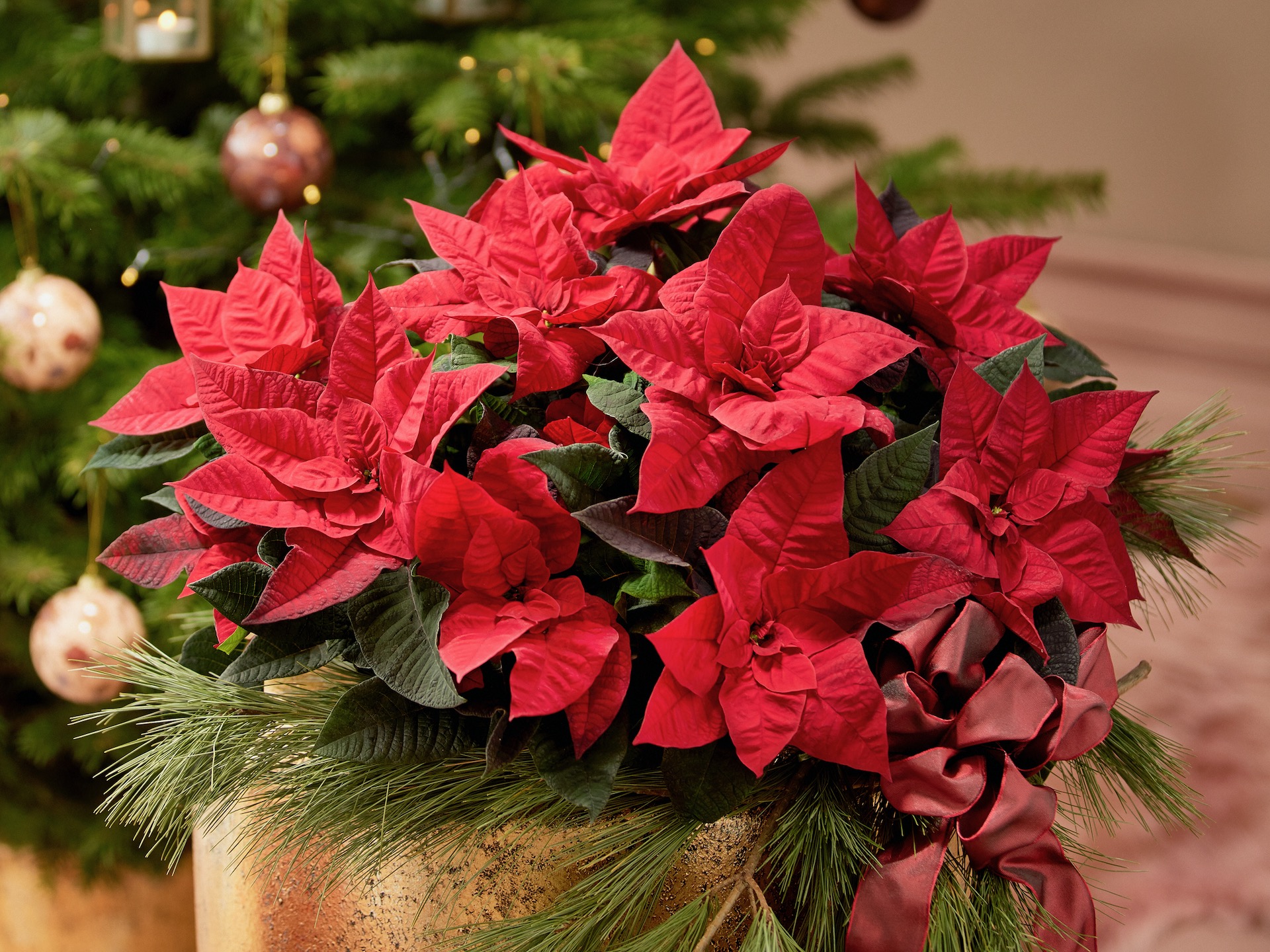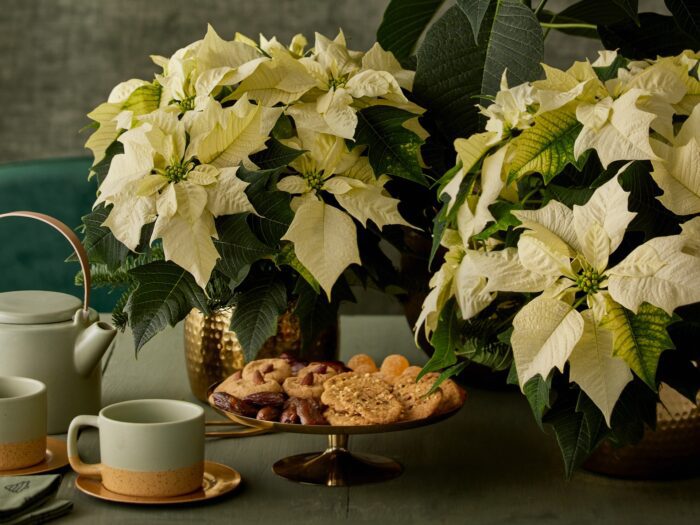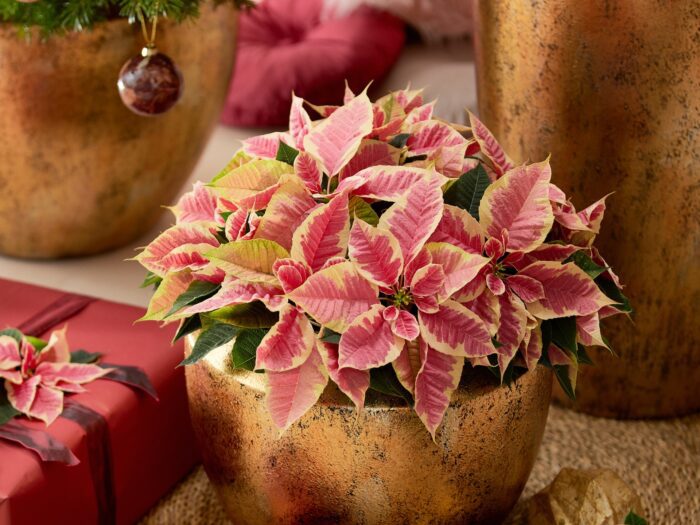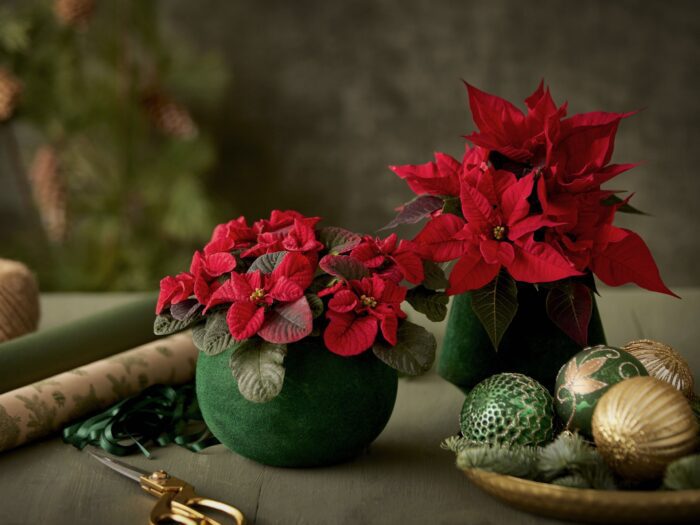
Poinsettia care tips to keep your plant alive past Christmas
Some Christmas trends don’t stand the test of time: upside-down trees and 1980s crepe paper ‘bells’ that tear within two minutes of being hung, we’re looking at you. But when it comes to festive decorating, the cheery poinsettia never goes out of style. But how do you keep your plant looking joyful through to Boxing Day and beyond? With our poinsettia care tips, that’s how.
Before you start, it’s worth knowing a little about what you’re dealing with.
“The Christmas tree won’t be the only tree in our houses this year,” says Pamela Smith, a gardens and parklands consultant at The National Trust. “That’s because poinsettias, in their native habitat in Mexico, are actually small trees.”
Elizabeth Marshall, seasonal buyer at Hillier Garden Centres and Nurseries, adds: “Euphorbia pulcherrima is commonly known as Poinsettia after Joel Robert Poinsett, the American ambassador to Mexico in the 1820s and 1830s. Modern varieties of poinsettia are available in a wide range of hues: reds, pinks, greens and more, but it is the rich red that is most commonly seen in homes during the festive season.”
Ready to take a poinsettia or two home for the holidays? Here’s how to take the best care of them.
Choose your poinsettia carefully
You may receive a poinsettia as a gift (lucky you), but if you’re buying your own, shop wisely.
“Poinsettias are generally a well-managed, well-produced plant – one of the best Christmas plants you can choose,” says Smith. “They are grown by the nursery trade in ideal conditions. They’ll have been watered just enough, been given the right compost, and been treated with the right levels of light to make the bracts [a poinsettia’s coloured leaves] turn red, white and so on.
“But, if they’ve been on the shelf a while, they may have dried out.”
She advises going for plants in the middle of the tray, as they might not have dried out as much.
“Next, you want one that’s bushy, rather than ‘leggy’, with several ‘leaders’ rather than just one upright stem.

“Also, turn them around,” Smith adds. “They’ll often be wrapped in cellophane and there may be dead leaves trapped inside. These dead leaves can cause disease when sat on the compost. But generally, poinsettias tend to go out of the nurseries and supermarkets quickly, so it’s quite hard to chose a bad one.”
Guy Barter, chief horticultural advisor at the RHS, advises choosing plants from heated indoor displays.
“Newly delivered plants are best,” he says. “If it isn’t already protected, ask to have the plant wrapped before taking it home, and avoid leaving it in the car while you do other errands. Chilled plants can shed their bracts and leaves.”
Unwrap and water if needed
You may need to give your plant a good soak when you get it home.
Smith explains: “While they will have been given the perfect amount of water at the nursery, once they’ve been put on a truck, taken to a garden centre or been tightly packed onto a supermarket shelf, they may have missed a watering or two.”
Position your poinsettia carefully
“Because they should actually grow a lot bigger into a tree, poinsettias have relatively big leaves for the size of the plant,” says Smith. “That means they can get knocked off easily, so don’t put your plant where it could be frequently disturbed.
There was talk for many years that poinsettias were poisonous. “But they aren’t, so having them in a house with children or pets isn’t an issue,” she adds.
According to Barter, poinsettias prefer temperatures of 16 to 21 degrees C.
“A coolish room is better than a hot room,” he says. “They won’t tolerate draughts, and centrally heated rooms are often too dry, especially if your plant is positioned near radiators or open fires. Standing a poinsettia on a tray of damp pebbles can help keep humidity up.”
Don’t overwater your poinsettia
The most crucial poinsettia care tip we can give is to water your plant correctly. Because, as Smith points out, “overwatering will kill it”.
Dobbies’ senior houseplant buyer, Claire Bishop, advises, “You should only water your poinsettia when the soil is noticeably dry to the touch. This will vary on the temperature of your home, so your plant could require watering every few days, or once a week depending on its surroundings. Poinsettias won’t thank you for waterlogged soil, so make sure they are planted in a pot with good drainage.”
Both Barter and Smith recommend watering from the top using tepid water.
Bishop adds: “They also like a humid environment, so a Poinsettia’s leaves will benefit from regular misting, which should prevent them from drying out when you have your heating on in winter.”
Adds Smith: “If the soil is too wet, it will feel cold to the touch even in your warm house. If it feels skin temperature and slightly damp, that’s ideal.”

So what do you do if you fear you’ve overwatered your poinsettia? “Lift it out of its saucer and make sure it’s not sat in any standing water,” says Pamela Smith. “Let it drain out properly and warm up a bit before returning it.”
You probably won’t have to feed it
“Most people will buy poinsettias as seasonal plants and aren’t expecting to keep them, so the growers make sure they will have enough food in the compost to keep them going until well after Christmas,” says Smith.
However, Barter suggests “giving them tomato feed every week to help keep them healthy”.
And if you are planning to keep your poinsettia beyond the Christmas period, Bishop says you should be feeding it.
“Your poinsettia will benefit from monthly feedings to keep it thriving long into the next year. Use a liquid plant food through the spring and summer months – with proper care, this will allow it to bloom again next Christmas,” she explains.
Why do the leaves of my poinsettia keep falling off?
Your poinsettia is most likely shedding leaves because it’s been overwatered.
“90% of the time, that’s the case,” says Smith. “It’s very rarely because they’ve got too warm or dried out. They drop leaves because they can’t get any air out of the water-clogged compost – the roots need air as well as water.”
Other culprits are exposure to draughts, or people or pets knocking the plant as they pass. Check the moisture level of the soil. If it feels warm and damp rather than cool and wet, watering isn’t the issue, so move it to a new position.

How do I save my poinsettias for next year?
We’re not going to lie – this can be tricky. But if you like a challenge, and were only going to chuck your poinsettias on the compost heap otherwise, you’ve nothing to lose.
“You can keep them alive – they are perennial,” explains Smith. “But the bracts – the coloured parts of the leaves – will drop off after Christmas. They’re not designed to be there all year round anyway, so don’t worry about that.”
Here are our top tips for preserving your poinsettas for the future.
Move them to a dark, cool spot
As they drop their leaves, you’ll need to water your plants less, and it’s a good idea to move them to somewhere cool and dark such as a porch or a bedroom that’s not used as much. Keep them there, out of the sunlight, until the spring.
“They’re almost going dormant, so you’re basically giving them the winter they would have in the wild in Mexico,” says Smith. “Don’t put them outside.”
Bring them out again in spring, and prune
“As long as you haven’t overwatered them, you should be able to bring them back out onto your sunny windowsill come Easter time,” Smith says.
To ensure your Poinsettia is healthy year-round, Bishop recommends pruning it twice a year.
“When it comes to spring, you should cut back your plant’s stems down to around six inches,” she says.
Similarly, Smith recommends bringing them down to around 10cm, which she says is easy to do with scissors. Just beware of the sap when you’re doing this. It can irritate the skin, so wash your hands afterwards.
Feed and repot as necessary
In spring, if you notice your poinsettia is growing, you can repot it into a larger container to accommodate its growing size.
“Make sure you use fresh potting mix with good drainage and choose a pot that’s big enough for the plant’s roots to grow,” Bishop says.
Smith recommends adding some houseplant fertiliser.
“Your plant will keep growing all through the summer. It’ll be green and leafy, but to keep it bushy, pinch the tops out so it doesn’t get too leggy,” she notes.
In September, limit their light intake
Now comes the tricky bit – getting the bracts to change colour again. So from September, you’ll need to limit the light the plant gets.
“For Christmas flowering, the plant’s day length must be carefully limited to 10 hours per day by placing it in darkness, away from any artificial lighting, for 14 hours,” advises Barter. “Fingers crossed, 10 hours of daylight at 18 degrees C over an eight-week period should lead to your poinsettia flowering at Christmas.”




